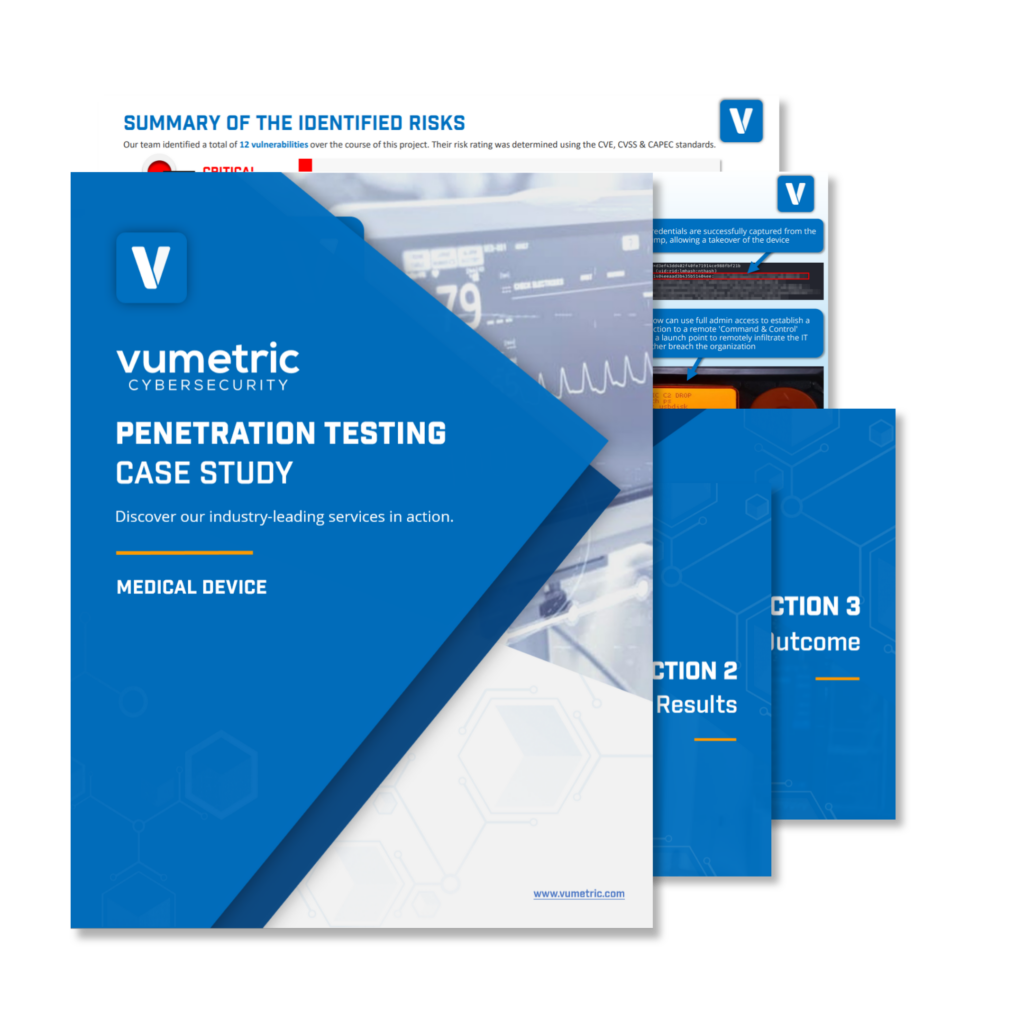In the rapidly evolving landscape of healthcare technology, the advent of Software as a Medical Device (SAMD) marks a transformative shift in the delivery of medical care. These innovative software solutions, capable of performing critical medical functions independently of traditional hardware-based medical devices, have revolutionized aspects of patient care, diagnosis, and management. Nonetheless, as with any significant technological advancement, this evolution brings with it a host of cybersecurity vulnerabilities. Given these emerging challenges, the importance of penetration testing becomes undeniable. This process, crucial for identifying and addressing potential security weaknesses, plays a pivotal role in ensuring the safety, privacy, and trust of patients relying on these technologies. Consequently, emphasizing a rigorous and skilled approach to penetration testing is essential for safeguarding the integrity and future of SAMD within the healthcare sector.
What Cyber Risks are SAMD Facing?
- Data Breaches: This involves unauthorized access to sensitive patient information, leading to the theft or exposure of personal health data. Such breaches compromise patient privacy and trust, making the protection of data paramount.
- Tampering with Medical Records: Unauthorized alteration or deletion of vital patient data can result in incorrect diagnoses or treatments. Ensuring the integrity of medical records is essential for accurate patient care.
- Device Functionality Manipulation: Unauthorized changes to how a device functions can severely endanger patient health by delivering incorrect treatment doses or interventions. Protecting device operations is critical for patient safety.
- Ransomware Attacks: Attackers may encrypt device data or functionality and demand a ransom for its release, severely disrupting patient care and access to medical services. Preparing for and mitigating ransomware attacks is crucial.
- Denial of Service (DoS) Attacks: These attacks overwhelm SAMD systems with traffic, making them unavailable to healthcare providers and patients. Ensuring system availability and resilience against DoS attacks is vital for continuous patient care.
- Phishing Attacks: By tricking individuals into disclosing login credentials or downloading malware, attackers can compromise SAMD security. Educating users on recognizing and avoiding phishing attempts is a key defense strategy.
- Software Vulnerabilities: Exploiting flaws in the SAMD’s software can allow unauthorized access or control. Regularly updating and patching software is essential to protect against these vulnerabilities.
What is SAMD Penetration Testing?
As Software and Medical Devices (SAMD) integrate further into healthcare, the cybersecurity stakes skyrocket. A cyberattack could result in stolen patient data, altered medical records, or manipulated device functions, posing serious risks to patient safety. Consequently, addressing cybersecurity isn’t merely a technical challenge; it’s crucial for patient safety.
Penetration testing emerges as a key defense mechanism in this context. Also known as pen testing or ethical hacking, this process involves simulating cyberattacks on systems to pinpoint vulnerabilities. For medical device manufacturers, penetration testing is vital. It allows them to identify and address security weaknesses before malicious hackers can exploit them, safeguarding patient safety and privacy.
Moreover, penetration testing transcends theoretical security assessments. It actively uncovers real-world risks to both patient safety and privacy. By simulating attacker strategies, manufacturers can strengthen their defenses, making SAMD safer. Essentially, penetration testing serves as an early detection system, highlighting potential threats before they manifest.
In embracing penetration testing, manufacturers not only comply with regulatory requirements but also prioritize patient safety. This commitment is critical in today’s fast-evolving digital and threat landscape. It ensures that healthcare providers and patients can trust SAMD, underscoring its role as a linchpin in modern healthcare delivery.
The Role of Penetration Testing in Securing SAMD
1. Enhancing Patient Safety:
One of the most significant roles of penetration testing in securing Software as a Medical Device (SAMD) is its direct impact on patient safety. By identifying vulnerabilities that could be exploited to alter device functionality, penetration testing helps prevent scenarios where device malfunctions could lead to adverse health outcomes. This is especially critical for devices that are integral to patient care, such as insulin pumps, pacemakers, and other life-sustaining systems. Ensuring these devices are resilient to cyberattacks is paramount, as the exploitation of a single vulnerability could lead to life-threatening situations.
2. Facilitating Technological Innovation:
As medical device manufacturers strive to innovate and integrate advanced technologies into their products, penetration testing becomes increasingly important. The adoption of Internet of Things (IoT) technologies, wireless connectivity, and cloud-based services introduces new vulnerabilities and attack vectors. Penetration testing allows manufacturers to explore innovative features and capabilities while ensuring they do not compromise the device’s security. This balance between innovation and security is crucial for the development of advanced medical devices that can deliver improved patient care without exposing patients and healthcare providers to new risks.
3. Ensuring Data Privacy:
With the increasing digitization of health information, medical devices often store and transmit sensitive patient data. Penetration testing plays a critical role in safeguarding this data against unauthorized access and breaches. By identifying vulnerabilities that could lead to data leaks, manufacturers can implement stronger data protection measures. This not only helps in complying with data protection regulations, such as the General Data Protection Regulation (GDPR) in the EU but also in maintaining patient confidentiality and trust.
4. Supporting Incident Response and Recovery:
Penetration testing also supports the development of effective incident response and recovery strategies. By simulating cyberattacks, manufacturers can evaluate their ability to detect, respond to, and recover from real-world security incidents. This preparedness is crucial for minimizing the impact of a breach and restoring normal operations as quickly as possible. It also aids in meeting regulatory requirements for incident response plans and can significantly reduce the legal and financial consequences of a cybersecurity incident.
5. Driving Industry-Wide Cybersecurity Improvements:
Finally, the practice of penetration testing by medical device manufacturers contributes to broader industry-wide improvements in cybersecurity. As manufacturers share best practices, lessons learned, and innovative security solutions (while respecting privacy and proprietary information), they contribute to a collective increase in cybersecurity knowledge and resilience. This collaborative approach not only benefits individual manufacturers but also enhances the overall security posture of the medical device industry, leading to safer and more reliable healthcare ecosystems.
Cybersecurity Best Practices to Secure SAMD
Penetration testing plays a crucial role in validating the effectiveness of cybersecurity measures implemented in Software and Medical Devices (SAMD). By identifying vulnerabilities, manufacturers can ensure their products meet the highest security standards. Below is a list of best practices for securing SAMD, essential for manufacturers aiming to safeguard their devices against cyber threats.
- Implement Strong Encryption: Utilize advanced encryption methods for both stored and transmitted data to safeguard against unauthorized breaches. This practice ensures the confidentiality and integrity of sensitive information, providing a secure environment for data handling.
- Regularly Update Software: Consistently apply updates and patches to software components, addressing known vulnerabilities. This ongoing maintenance is essential for protecting against the exploitation of software flaws and countering emerging cybersecurity threats.
- Adopt Role-based Access Control (RBAC): Implement RBAC policies to restrict access to sensitive data, adhering to the least privilege principle. This approach minimizes the risk of data breaches by ensuring only authorized users can access critical information.
- Enable Secure Boot: Activate secure boot protocols to prevent the execution of unauthorized software at startup. This security measure guarantees that only verified and trusted software can operate on the device, enhancing its defense against malicious attacks.
- Monitor and Log Activity: Implement continuous monitoring of system operations and maintain detailed logs for auditing purposes. This strategy aids in the early detection of anomalous activities, enabling swift response to potential security incidents.
- Develop a Robust Incident Response Plan: Establish a comprehensive plan for responding to security breaches, outlining clear procedures for quick and efficient action. This preparedness is key to minimizing the damage of cyber incidents and ensuring a rapid return to normal operations.
By following these best practices, manufacturers can significantly enhance the security of their Software and Medical Devices, ensuring they remain resilient against evolving cyber threats.
Conclusion
The integration of Software as a Medical Device (SAMD) into healthcare significantly highlights the urgent need for robust cybersecurity measures. Consequently, penetration testing becomes crucial, as it enables manufacturers to proactively address vulnerabilities, thereby ensuring patient safety, data privacy, and user trust. Furthermore, emphasizing systematic and skilled penetration testing is key to safeguarding the future of SAMD in healthcare. For more information on penetration testing services or to get in touch, visit our services page or contact us. This approach not only protects against cyber threats but also supports the ongoing innovation and acceptance of SAMD in the healthcare sector.




